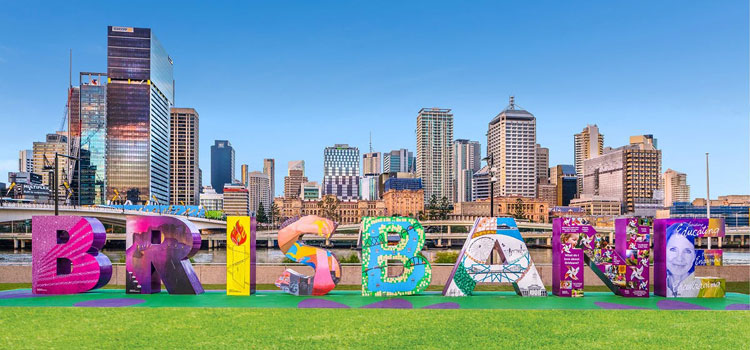Population: Over 1 million residents. Between 2014 and 2015 the population increased by 1.6%.
Geography: Large city on the Brisbane River. Area of approx. 1,338 km2; Brisbane is made up of 188 mainland suburbs, with additionalislands and localities in Moreton Bay.
Main challenge: Floods, droughts & variable climatic conditions. Primary water supply from Wivenhoe Dam, 70 km northwest of CBD.
Main solution: Brisbane City Council is working closely with local stakeholders to achieve a vision of a clean and green city, increasing the use of natural assets and implementing adaptation measures for flood and sea level rise.
Brisbane’s Water Vision and Challenges
Brisbane has come a long way on the water wise journey. From a small outpost that struggled to provide its residents with clean drinking water during the early 1800s, Brisbane has become a sophisticated city that manages water at all stages of the water cycle and is known for its leading edge management of water in flood and drought.
Water defines Brisbane as a river city. It provides a sense of place through 4,000 kilometres of waterways; that supports the population, biodiversity and extensive natural areas. Brisbane is renowned for its riverside location, subtropical climate and friendly relaxed lifestyle – all of which attract businesses, workers, students and tourists from across the world.
Brisbane City Council’s long term vision is for Brisbane to be one of the cleanest and greenest of the world’s capital cities. That, “our subtropical open spaces and natural areas provide breathing spaces for the city” and “our river, creeks and bay are enhanced, protected and enjoyed by all.” Brisbane Vision 2031.
Integrated management of world class natural resources is an essential approach for a resilient and liveable city like Brisbane. In the past two decades, Brisbane has experienced the millennium drought (1995 – 2009) and two significant floods (2011 and 2013), and as a subtropical city it is also affected by frequent and severe storms. These experiences have driven Brisbane to adapt, recover and thrive in the face of these climatic events.

A Shared Regional Vision for Planning in Partnership
The floods and droughts in Brisbane have highlighted the importance of managing water at all stages of the water cycle and has reshaped Brisbane’s relationship with water. With community education strategies and sharpened government policies on water conservation, recycling and reuse, Brisbane has become a city of water savers. During the millennium drought, Brisbane residents reduced their water consumption from 300 to 127 litres per day. (Brisbane’s Total Water Cycle Management Plan)
Regional collaboration is the hallmark of Brisbane’s sustainable urban water story. Brisbane City Council works in partnership with multiple stakeholders to ensure secure, healthy and sustainable water resources. These partners include Queensland Government, neighbouring local councils, community groups, businesses, industries and many others.
Brisbane also partners and supports its globally recognised research institutes and programs, bringing opportunities to the city to implement tailored and leading-edge water solutions. Urban planners and water professionals have collaborated to create areas that handle flood risk. This has resulted in increased urban green spaces, amenity and overall liveability for the community
Case Study: Norman Creek catchment
The Norman Creek catchment is one of the city’s most urbanised places, separated from the CBD only by the Brisbane River. Council’s Norman Creek 2012-2031 Master Plan acknowledges the rich urban fabric of the catchment. This is achieved by providing new opportunities to bring nature back into the area by re-establishing natural processes and reconnecting communities with their waterways. The Master Plan is not just about rejuvenating local waterways, but also about achieving multiple outcomes for the city, from strengthening the economy; to improving access and inclusion for all residents, all of which is based on the one principle; designing with water in mind.
5 Building Blocks for Brisbane on the journey to water-wise cities
Vision – Brisbane 2031- Brisbane is a Clean and Green City. This vision of the city is backed by Brisbane’s WaterSmart Strategy, Total Water Cycle Management Plan and FloodSmart Future Strategy.
Governance – Having a strong governance model is essential to achieving the water vision for the City. Working with all parties and stakeholders across the City allows Brisbane to refine policy and delivery models. Collaboration and communication is the key to ensuring the regional governance model operates effectively.
Knowledge & Capacity – The CRC Water Sensitive Cities, the Australian Rivers Institute, the Advanced Water Management Centre, the International River Foundation and Healthy Waterways all of which are based in Brisbane and all contribute significantly to developing water knowledge and capacity in the region and all influence the global water conversation.
Planning Tools – Coordinated planning in South East Queensland provides the structure for Brisbane to develop integrated and innovative planning outcomes. The SEQ Regional Plan sets regional outcomes and dwelling targets and expresses the regional interest of the Queensland Government and allows these to be expressed by the City.
Implementation Tools – Council’s annual budget has identified almost $80 million to be invested in water or water related projects across the City during 2016/17. Council has committed to revitalising the run-down Oxley Creek catchment into a 600 hectare world class green corridor and leisure landmark which is now a reality with a commitment of $15 million over the next four years.

